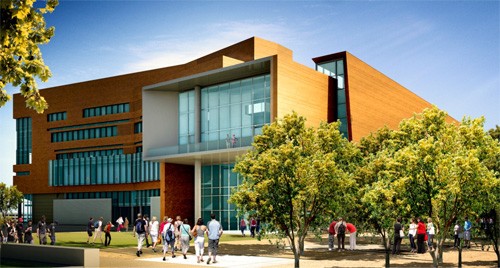The UA received $15 million from the National Institutes of Health to finance an animal research facility at the UA’s biomedical campus in Phoenix.
The grant, part of the federal stimulus, will pay for a portion of the new underground animal research lab.
According to Al Bravo, associate director of public affairs for the UA College of Medicine in Phoenix, the building is being built underground because it will save money and be more environmentally friendly.
The building is being designed with sustainability in mind. It will be built with energy-efficient materials and is designed to reduce water usage.
More than 30 researchers and staff will work at the new lab, which is part of the University of Arizona College of Medicine-Phoenix in partnership with Arizona State University campus.
Dr. Bill Crist, vice president for health affairs at the UA, says it’s the first phase of expansion.
“”Three years ago, we expanded the medical school from Tucson up to Phoenix. So now, there is a UA medical school in downtown Phoenix because we need to produce more doctors. There’s just such a physician shortage in Arizona,”” Bravo said.
The UA plans to expand the Phoenix campus so it can produce a similar number of physicians as the medical school in Tucson.
Right now, about 115 medical students are accepted at the Tucson campus per class. At the Phoenix campus, about 48 students per class are admitted. The goal is to eventually accept about 120 at the Phoenix campus.
“”We’re really excited because it’s the first grant for construction of the Phoenix campus,”” Crist said. “”It’s money we don’t have to borrow or ask the state for.””
Rats and mice for medical research will be housed in the lab.
“”You can’t do many components of medicine without animals,”” Crist said.
He added that the UA’s policies are very strict when it comes to the welfare of the animals. He said the animals are cared for by veterinarians and that everything is done as humanely as possible.
Some research involving animals includes cardiovascular cancer research and vitamin D research.
The Phoenix campus opened in 2006 for researchers from the UA, Arizona State University and the Transnational Genomics Research Institute to use. Classes began in the fall of 2007.
Up until this year, only Arizona residents were accepted to the medical school in Phoenix. Of the class applying for the fall of 2010, 25 percent can be from out of state.
“”We want to make sure they’re practicing in Arizona in addition to training here,”” Bravo said.
The UA estimates this project will create about 250 temporary jobs related with the construction of the building and 33 full time research positions.
“”All of the faculty that are teaching our students are researchers, we know that the best teachers are those that are on the cutting edge of what the latest is in medicine,”” Bravo said. “”Some do research that involves rats and mice.””
The UA should receive the money from the grant in the next few months, according to Crist, and construction will follow shortly thereafter.









